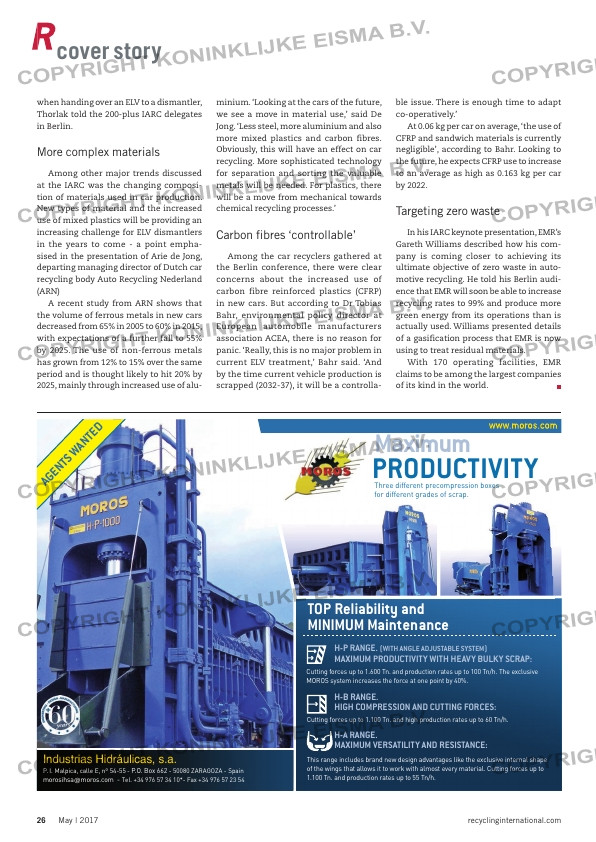Page 28 from: Edition 3 2017

26 May | 2017
cover story
recyclinginternational.com
when handing over an ELV to a dismantler,
Thorlak told the 200-plus IARC delegates
in Berlin.
More complex materials
Among other major trends discussed
at the IARC was the changing composi-
tion of materials used in car production.
New types of material and the increased
use of mixed plastics will be providing an
increasing challenge for ELV dismantlers
in the years to come – a point empha-
sised in the presentation of Arie de Jong,
departing managing director of Dutch car
recycling body Auto Recycling Nederland
(ARN)
A recent study from ARN shows that
the volume of ferrous metals in new cars
decreased from 65% in 2005 to 60% in 2015,
with expectations of a further fall to 55%
by 2025. The use of non-ferrous metals
has grown from 12% to 15% over the same
period and is thought likely to hit 20% by
2025, mainly through increased use of alu-
minium. ‘Looking at the cars of the future,
we see a move in material use,’ said De
Jong. ‘Less steel, more aluminium and also
more mixed plastics and carbon fibres.
Obviously, this will have an effect on car
recycling. More sophisticated technology
for separation and sorting the valuable
metals will be needed. For plastics, there
will be a move from mechanical towards
chemical recycling processes.’
Carbon fibres ‘controllable’
Among the car recyclers gathered at
the Berlin conference, there were clear
concerns about the increased use of
carbon fibre reinforced plastics (CFRP)
in new cars. But according to Dr Tobias
Bahr, environmental policy director at
European automobile manufacturers
association ACEA, there is no reason for
panic. ‘Really, this is no major problem in
current ELV treatment,’ Bahr said. ‘And
by the time current vehicle production is
scrapped (2032-37), it will be a controlla-
ble issue. There is enough time to adapt
co-operatively.’
At 0.06 kg per car on average, ‘the use of
CFRP and sandwich materials is currently
negligible’, according to Bahr. Looking to
the future, he expects CFRP use to increase
to an average as high as 0.163 kg per car
by 2022.
Targeting zero waste
In his IARC keynote presentation, EMR’s
Gareth Williams described how his com-
pany is coming closer to achieving its
ultimate objective of zero waste in auto-
motive recycling. He told his Berlin audi-
ence that EMR will soon be able to increase
recycling rates to 99% and produce more
green energy from its operations than is
actually used. Williams presented details
of a gasification process that EMR is now
using to treat residual materials.
With 170 operating facilities, EMR
claims to be among the largest companies
of its kind in the world.
TOP Reliability and
MINIMUM Maintenance
Maximum
PRODUCTIVITY
H-P RANGE. (WITH ANGLE ADJUSTABLE SYSTEM)
MAXIMUM PRODUCTIVITY WITH HEAVY BULKY SCRAP:
Cutting forces up to 1.100 Tn. and high production rates up to 60 Tn/h.
H-B RANGE.
HIGH COMPRESSION AND CUTTING FORCES:
H-A RANGE.
MAXIMUM VERSATILITY AND RESISTANCE:
This range includes brand new design advantages like the exclusive internal shape
of the wings that allows it to work with almost every material. Cutting forces up to
1.100 Tn. and production rates up to 55 Tn/h.
Three different precompression boxes
for different grades of scrap.
Cutting forces up to 1.600 Tn. and production rates up to 100 Tn/h. The exclusive
MOROS system increases the force at one point by 40%.
P. I. Malpica, calle E, nº 54-55 – P.O. Box 662 – 50080 ZARAGOZA – Spain
[email protected] – Tel. +34 976 57 34 10* – Fax +34 976 57 23 54
Industrias Hidráulicas, s.a.
AG
EN
TS
W
AN
TE
D
C
M
Y
CM
MY
CY
CMY
K



